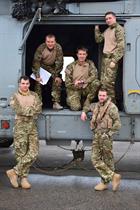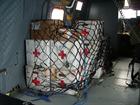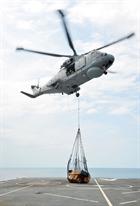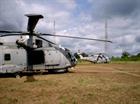A day's flying with Operation Gritrock
The working day starts early onboard RFA Argus for aircrew of 820 Naval Air Squadron flying sorties acrossSierra Leone, as part of Operation Gritrock.
Overnight tasking has come into the Ship to take a load-lifting team up country and pick up stores in an under-slung net and bring it back to RFA Argus. Lieutenant Rich Beaumont is a Merlin pilot with 820 NAS and takes up his story.
“My alarm goes off at 0600, it’s not long until I need to be ‘turned to’ so I have a quick shower and get rigged in my uniform. My first event is the Ship’s flying brief at 0630. This is followed by the aircraft’s crew brief where we go through tasking we have for the day and plan how we are going to do this.
Today’s first sortie doesn’t lift until 1030, so I have breakfast after the brief and make sure that my kit is ready for the mission. It is very important to take enough water as the cockpit gets very hot and I also check through my ‘Downbird bag’. This contains all the equipment I may need if our aircraft develops a problem and we get stranded somewhere or if we have an accident. For example a change of uniform, survival knife, torch, first aid kit, some food and a fire-lighting kit.
At 1030 we launch for the first mission, load-lifting stores. Flying with a large object hanging below the aircraft is tricky, not least because I can’t see it from the cockpit. Close cooperation with the Aircrewman in the cargo door is essential. He leans out to keep an eye on the load and provides precise instructions to ensure that it is placed down onto the deck in exactly the right place.
Our next task is to take stores to an Army Medical team who are based at Makeni, deep into Sierra Leone and very time-consuming to reach by road. The Aircrewman and Observer spend 10 minutes ‘lifting and shifting’ the kit inside. They make sure that it is secured well so that it doesn’t shift around during flight. We also pick up a recce team who are coming along for the ride so that he can conduct reconnaissance of potential Casualty Evacuation landing sites along the way.
The flight takes about 30 minutes, along the way we see a Landing Craft manned by our Royal Marines coming along the river so we descend and give them a wave on the way past. Once at Makeni, we have a quick airborne look at our intended landing site, which is a football pitch. There are large trees around two sides, some goalposts and the surface is dusty. We plan our route in and out; considering what we will do if an engine fails during the approach. The dust can be a problem if it billows up around the aircraft, preventing us seeing the ground. So we decide to use a “double-angle approach to a zero/zero landing” – this will allow us to clear the trees whilst minimizing the effects of a dust cloud.
We drop the stores to the grateful soldiers who load it into their pickup. I notice the Republic of Sierra Leonean Armed Forces (RSLAF) personnel have set up a cordon around us to stop the excited children running up to the helicopter. They are all clearly quite thrilled to see us, but could get hurt or blown over if they get too close so I am relieved that the RSLAF are looking out for them.
We lift off from the football pitch using a “towering takeoff”- this allows us to stay over the landing site until we are high enough that we would be able to dive away safely in the event of an engine failure. We head for Freetown and RFA Argus. En-route we keep a lookout for potential landing sites. Spotting what looks like another sports pitch; we note down its location, map co-ordinates and take some photos. It looks ideal and has good access to the main road for ambulances. The rest of the flight back is uneventful, and we land back on the Argus at 1630 and shut down the aircraft.
After a post-flight walk-round our Merlin we head back inside and debrief what we did during the sortie. We have spent 4:30 flying and been manned up in the aircraft for 6 hours! I have another shower and change out of my dirty flying kit and then head off for a very welcome hot meal”.





